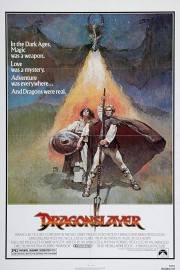Dragonslayer
Before the ’80s All Over Podcast put it firmly on my radar, Matthew Robbins’s “Dragonslayer” was a name I was aware of for another, more obscure, reason. The composer on the film, Alex North, had supposedly utilized elements of his unused score for Kubrick’s “2001: A Space Odyssey” in his score for “Dragonslayer,” and sure enough, those elements are heard clear as day by someone who is well-versed in that score thanks to a recording in the ’90s. There’s more than just that bit of trivia to recommend “Dragonslayer” on, though.
There is a lot to be said about fantasy films pre-“Harry Potter” and “Lord of the Rings,” and certainly not a lot of good, but a movie like “Dragonslayer” stands out for its ambition and imagination, even if the script by Robbins and Hal Barwood has little in the way it builds its hero’s quest in a post-“Star Wars” world. Yes, we recognize a lot of the story beats as sorcerer’s apprentice Galen, played by Peter MacNicol in his first film role (and miscast, in my opinion), is sent by his master, Ulrich (Ralph Richardson), to go slay the dragon, Vermithrax, which has terrorized the land for ages, only sated by the sacrifice of virginal women from a nearby village. That is all there is to the plot, and whether it engages you or not will determine how much mileage you get out of it.
“Dragonslayer” has a very familiar structure in how it builds its story, although there are choices along the way that were not quite cliche just yet. The king of the valley, Casiodorus (Peter Eyre), has rigged the selection process for the sacrifice to Vermithrax, to protect his daughter from being selected. The main female lead, Valerian (Caitlin Clarke), is dressed (and “mistaken”) as a boy to avoid being part of the lottery, and she is not really a damsel in distress. Galen’s mentor “dies” early on, only to be brought back when he needs him the most. And Galen’s series of missteps on his quest all involve attempts to slay Vermithrax; each time he tries, he gives it effort, but each one incures the dragon’s wrath a bit more- the film’s structure may seem familiar, but there are certainly beats and “false endings” that made it unfamiliar, at the time, like Robbins and Barwood were trying things out as they attempted to do something original. This is quite a film on which to experiment with storytelling tropes.
On the whole, I found myself taken by “Dragonslayer.” I’m always a sucker for this “hero’s journey” type of narrative, especially if it is set in a science fiction or fantasy setting. I’m not a huge fan of MacNicol in this role, but he serves the film’s purpose well enough, and the characters around him (especially Valerian) pick up the slack. All praise be to the visual effects artists, many of whom came out of Industrial Light & Magic, who brought Vermithrax to life- even almost 40 years later, it’s hard not to get a thrill out of watching him go to work in this movie, especially near the end. There is a great sequence of Galen going in to Vermithrax’s underground lair that really stands up with the best fantasy set pieces of both that era, as well as the past two decades of fantasy filmmaking. Along the way, this has more than enough visual imagination and narrative strength to hold one’s interest, especially if you like your fantasy with a bit of cheese thrown on top of it. And it’s got some strong music by Alex North on top of it, even though I swear I’ve heard some of those motifs before.










